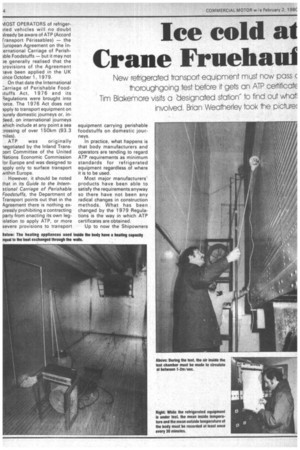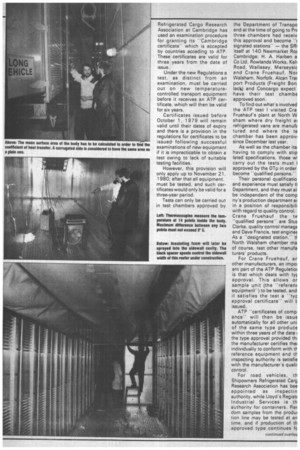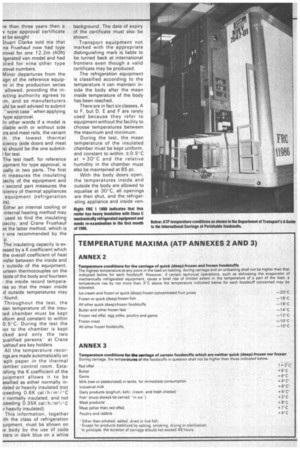Ice cold at Crane Fruchaul
Page 76

Page 77

Page 78

Page 79

If you've noticed an error in this article please click here to report it so we can fix it.
New refrigerated transport equipment must now pass thoroughgoing test before it gets an ATP certificatE Tim Blakemore visits a designated station to find out what involved. Brian Wea erley took ne picture
VlOST OPERATORS of refrigerited vehicles will no doubt )Iready be aware of ATP (Accord fransport Perissables) — the European Agreement on the In.ernational Carriage of Perish)ble Foodstuffs — but it may not )e generally realised that the Provisions of the Agreement lave been applied in the UK ince October 1, 1979.
On that date the International :arriage of Perishable Food;tuffs Act, 1976 and its Regulations were brought into brce. The 1976 Act does not apply to transport equipment on Durely domestic journeys or, iniced, on international journeys Nhich include at any point a sea rossing of over 150km (93.3 miles).
ATP was originally negotiated by the Inland Transport Committee of the United Nations Economic Commission For Europe and was designed to apply only to surface transport Nithin Europe.
However, it should be noted that in its Guide to the intern9tional Carriage of Perishable Foodstuffs, the Department of Transport points out that in the Agreement there is nothing expressly prohibiting a contracting party from enacting its own legislation to apply ATP, or more severe provisions to transport
equipment carrying perishable foodstuffs on domestic journeys.
In practice, what happens is that body manufacturers and operators are tending to regard ATP requirements as minimum standards for refrigerated equipment regardless of where it is to be used.
Most major manufacturers' products have been able to satisfy the requirements anyway so there have not been any radical changes in construction methods. What has been changed by the 1979 Regulations is the way in which ATP certificates are obtained.
Up to now the Shipowners Refrigerated Cargo Research Association at Cambridge has used an examination procedure for granting its "Cambridge certificate" which is aecepted by countries acceding to ATP. These certificates are valid for three years from the date of issue.
Under the new Regulations a test, as distinct from an examination, must be carried out on new temperaturecontrolled transport equipment before it receives an ATP certificate, which will then be valid for six years.
Certificates issued before October 1, 1979 will remain valid until their dates of expiry and there is a provision in the regulations for certificates to be issued following successful examinations of new equipment if it is impracticable to obtain a test owing to lack of suitable testing facilities.
However, this provision will only apply up to November 21, 1980; after that all equipment. must be tested, and such certificates would only be valid for a three-year period.
Tests can only be carried out in test chambers approved by the Department of Transpo and at the time of going to Pre three chambers had receiv this approval and become "( signated stations" — the SRI itself at 140 Newmarket RoE Cambridge; H. A. Harben a Co Ltd, Rowlands Works, KO Road, Wallasey, Merseysic and Crane Fruehauf, Nor Walsham, Norfolk. Alcan Trar port Products (Freight Bon: lacla) and Concargo expect have their test chambe :approved soon.
To find out what's involved the ATP test I visited Cra Fruehauf's plant at North W sham where dry freight al refrigerated vans are manufE tured and where the te chamber has been approvi since December last year.
As well as the chamber its. having to comply with stip lated specifications, those wl carry out the tests must I approved by the DTp in order become "qualified persons,"
Their personal qualificatio and experience must satisfy tl Department, and they must al: be independent of the comp ny's production department ar in a position of responsibili with regard to quality control. Crane Fruehauf the tit "qualified persons" are StuE Clarke, quality control manage and Dave Francis, test engineE As a "designated station," ti North Walsham chamber ma of course, test other manufa turers' products.
For Crane Fruehauf, ar other manufacturers, an imp' ant part of the ATP Regulatior is that which deals with typ approval. This allows or sample unit (the "referent equipment") to be tested, and it satisfies the test a "typ approval certificate" will issued.
ATP "certificates of comp ance" will then be issue automatically for all other uni of the same type produce within three years of the date the type approval provided th; the manufacturer certifies thet individually to conform with if reference equipment and if inspecting authority is satisfie with the manufacturer's qualit control.
For road vehicles, th Shipowners Refrigerated Carg Research Association has bee appointed as inspectin authority, while Lloyd's Registt Industrial Services is th authority for containers. Rar dom samples from the produi tion line may be tested at an time, and if production of th approved type continues fc re than three years then a v type approval certificate st be sought.
Stuart Clarke told me that ne Fruehauf now had type Koval for one 12.2m (40ft) igerated van model and had )lied for nine other type noval numbers.
Minor departures from the ;ign of the reference equipnt in the production series allowed, providing the in)cting authority agrees to im, and so manufacturers uld be well advised to submit "worst case— when applying type approval.
In other words if a model is iilable with or without side )rs and meat rails, the variant th the lowest thermal iciency (side doors and meat Is) should be the one submitlfor test.
The test itself, for reference Jipment for type approval, is ually in two parts. The first rt measures the insulating mcity of the equipment and second part measures the iciency of thermal appliances equipment (refrigeration its).
Either an internal cooling or internal heating method may used to find the insulating pacity, and Crane Fruehauf as the latter method, which is one recommended by the p.
The insulating capacity is exassecl by a K coefficient which the overall coefficient of heat nsfer between the inside and 3 outside of the equipment. urteen thermocouples on the tside of the body and fourteen the inside record temperares so that the mean inside d outside temperatures may !found.
Throughout the test, the ean temperature of the insuted chamber must be kept dorm and constant to within 0.5'C. During the test the or to the chamber is kept cked and only the two qualified persons" at Crane uehauf are key holders.
All the temperature recorngs are made automatically on
• aph paper in the thermal iamber control room. Estaishing the K coefficient of the iuipment allows it to be assified as either normally indated or heavily insulated (not (ceeding 0.6K cal / h / m'/"C .r normally insulated, and not zceeding 0,35K cal /h/rn'/'C ,r heavily insulated).
This information, together ith the class of refrigeration iuipment, must be shown on ie ,body by the use of code tters in dark blue on a white
background. The date of expiry of the certificate must also be shown.
Transport equipment not marked with the appropriate distinguishing mark is liable to be turned back at international frontiers even though a valid certificate may be produced.
The refrigeration equipment is classified according to the temperature it can maintain inside the body after the mean inside temperature of the body has been reached.
There are in fact six classes, A to F, but D, E and F are rarely used because they refer to equipment without the facility to choose temperatures between the maximum and minimum.
During the test, the mean temperature of the insulated chamber must be kept uniform, and constant to within ±0.5C at 430' C and the relative humidity in the chamber must also be maintained at 85 pc.
With the body doors open, the temperatures inside and outside the body are allowed to equalise at 30'C, all openings are then shut, and the refrigerating appliance and inside ven Right: FRC 1 1966 indicates that this reefer has heavy insulation with Class C mechanically refrigerated equipment and needs re-examination in the first month of 1986.
tilating appliances •(if any) are started at maximum capacity.
When the temperature reqaired by the ATP class to which he equipment is presumed to aelong is reached, a heater with
capacity equal to 35 per cent )f the heat exchanged through he walls is started up inside the aody. To achieve Class A under hese conditions the mean inernatl temperature must be leld at O'C, for Class B —10 C, Ind for Class C If the xady is not "'reference equipnentfor type approval and the efrigeration unit has been ested separately to the sattsfacion of the inspecting authority, hen it may be classified by cal:ulation and without a practical est.
For whatever class, the efrigerating capacity of the ppliance must exceed the heat asses through the walls, multi plied by a factor of 1.75.
I have heard of one hopeful operator who thought that the cost of an ATP certificate was just that — that is 80p. Unfortunately, that is not the case. . The fees are laid down in The International Carriage of Perishable Foodstuffs (Fees) Regulations 1979 and are shown in the DTp"s -A Guide to the International Carriage of Perishable Foodstuffswhich also contains much other information on ATP.
The most expensive procedure is when a unit of transport equipment is tested as ''reference equipment' for type approval. Here £550, plus VAT, includes the fee charged to ensure conformity of production. A designated station charges £160, plus VAT, for each day or part of a day when its facilities are used for testing transport equiprnent.








































































































































